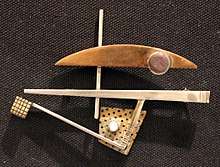Peter Macchiarini

Peter Macchiarini (August 27, 1909 – July 3, 2001) was an Italian-American California-based American Modernist jeweler and sculptor who was a pioneer in the field of avant-garde jewelry. He maintained an art studio and shop on Grant Avenue in San Francisco, California, for more than 50 years and was instrumental in organizing the first San Francisco outdoor art festival in 1938[1] as well as founding the Upper Grant Avenue Street Fair in 1953, an event that spawned similar artist-run festivals in the San Francisco Bay Area.
Macchiarini was born in Santa Rosa, California, on the Wohler Ranch in Sonoma County, in 1909. In 1923, when he was thirteen, he and his family moved to the northwestern region of Italy, where he went on to study for four years at the Art Academy in Pietrasanta.[2] Macchiarini returned to the United States in 1928 and, with the arrival of the Great Depression worked from 1929 to 1935 as a stonecarver, with several Bay Area firms; some of which were funded by the Federal Arts Project of the Works Progress Administration (WPA). While employed as a stonecarver, he worked on projects in the 1930s with such sculptors as Beniamino Bufano[3] and Ralph Stackpole. Like Bufano, Stackpole, and many other Bay Area artists, Macchiarini was active on the political Left. At a student demonstration during the 1934 West Coast waterfront strike, he was severely beaten by San Francisco police officers:
A talented young local sculptor, Peter Macchiarini, was thrown into the police patrol bleeding from the ears with a fractured skull. Despite the entreaties of other prisoners that he was dying, he was thrown in a cell and not removed to a hospital until many hours later, when his cellmates gave evidence that if something were not done about him they would shake the bars off the cage and scream the roof off the jail.
It was many months before Pete’s head mended, and when he was able to get around again he had to face trial on charges of rioting.
In 1936, following the suggestion of jeweler/ artist Margaret De Patta,[4] he started to create art jewelry and began his own jewelry studio. After studying art at the California School of Fine Art (now known as the San Francisco Art Institute) he went on to teach metalsmithing and jewelry making at Mills College during the summer sessions from 1952 to 1955 as well as, in the same period, in his own studio.
In 1980, he was awarded a gold medal from the Association of the Lucchesi nel Mondo, which annually recognizes those who, as citizens abroad, bring honor to the Italian province of Lucca through personal merit. In 2000, the San Francisco Board of Supervisors renamed a portion of Kearny Street — near Telegraph Hill — "The Peter Macchiarini Steps" in his honor.[5] On June 29, 2001 he was declared an official "San Francisco Legend" for his contributions to the local culture.
Notes
- ↑ "The Outside Turns Inward". Echoes. 8 (3). Winter 1999. p. 75.
- ↑ "Peter Macchiarini A Modern Bohemian". Metalsmith. Winter 1989. p. 34.
- ↑ "Archives of American Art". Smithsonian, interview by Mary Fuller McChesney. October 18, 1964. p. 5.
- ↑ "Messages of Modernism; American Studio Jewelry 1940 - 1960". 1996. pp. 134–139.
- ↑ "Farewell to an Artist". North Beach Journal. August 2001. p. 8.